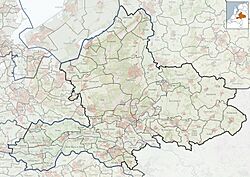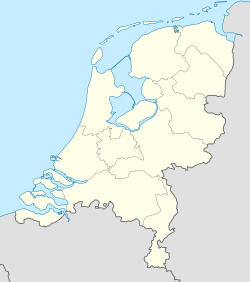Groenlo facts for kids
Quick facts for kids
Groenlo
|
|||
|---|---|---|---|

Two church of Groenlo
|
|||
|
|||
| Country | Netherlands | ||
| Province | Gelderland | ||
| Municipality | Oost Gelre | ||
| Area | |||
| • Total | 27.84 km2 (10.75 sq mi) | ||
| Elevation | 25 m (82 ft) | ||
| Population
(2021)
|
|||
| • Total | 9,860 | ||
| • Density | 354.17/km2 (917.3/sq mi) | ||
| Time zone | UTC+1 (CET) | ||
| • Summer (DST) | UTC+2 (CEST) | ||
| Postal code |
7141
|
||
| Dialing code | 0544 | ||
| Website | www.groenlo.nl | ||
Groenlo (pronounced 'GROON-loh') is a city in the eastern part of the Netherlands. It is located near the German border, in a region of the Gelderland province called the Achterhoek. This name means "back corner."
Groenlo was its own local government area until 2005. Then, it joined with another town, Lichtenvoorde. Together, they formed the new municipality of Oost Gelre. As of 2021, about 9,860 people live in Groenlo. The city is also known by its older names, Grolle, Grol, or Grol.
Today, Groenlo is mainly known for its beer brewery, Grolsch. The name Grolsch actually means "from Grol." The brewery started in 1615. Although the main brewery moved in 2004, Grolsch still makes many special beers. These beers are sold all over the world.
Contents
Groenlo's Rich History
Groenlo began around the early 600s. Its name comes from a "green wood" or forest nearby. Groen means "green," and lo means "forest." This is why Groenlo's old shield shows a green tree.
Becoming a City
Groenlo became part of the Guelders region. On December 2, 1277, it was given "city rights" by Reinoud I of Zutphen. This meant Groenlo could govern itself more. The city had six council members, including four aldermen and two mayors.
Trade and Fortifications
Since 1406, Groenlo was part of the bishopric of Münster. The city was an important place for trade. It was located on a busy trade route between Germany and the Netherlands. This led to many different guilds, which were groups of skilled workers.
Groenlo became a very strong fortified city in the 1500s and 1600s. During the Eighty Years' War, the city was attacked and surrounded many times. Today, you can still see parts of its old defenses. These include a defensively shaped canal and remains of its strong walls, called bulwarks.
Famous Sieges and Battles
In 1597, Maurice of Nassau captured Groenlo. But in 1606, Spanish troops led by Spinola took it back. A very important event happened in 1627. Groenlo was attacked and captured by Frederik Hendrik.
This event is still remembered in Groenlo today. You can find street names and restaurants named after Frederik Hendrik or "Het Belegh van Grol" (The Siege of Grol). Sometimes, people even re-enact these old battles from the Eighty Years' War. These re-enactments bring many visitors to the city.
Tourism and Restoration
Tourism is very important for Groenlo. Over 3,500 tourists often stay overnight in the area. To attract more visitors, some of Groenlo's old bulwarks were restored in 2007. This project caused some discussion because many large trees had to be cut down.
Catholic Traditions
Groenlo was under Spanish control for a long time. This history left a lasting mark on the city. Most people in Groenlo are Catholic. This is a bit unusual for the region, which is mostly Protestant.
Because of this, Groenlo celebrates several Catholic traditions. These include Carnaval and "Kermis," which is a fun fair. The city also has many places for celebrations and festivals.
Gallery
See also
 In Spanish: Groenlo para niños
In Spanish: Groenlo para niños









